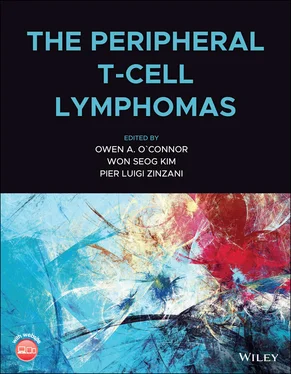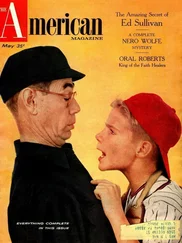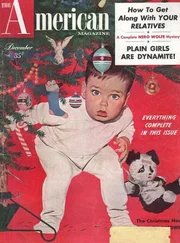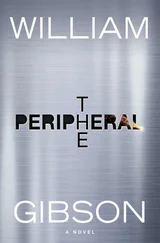Source: Claudio Tripodo, Stefano Pilleri.
Cortical thymocytes exhibit an immature T‐cell phenotype and express a characteristic repertoire of proteins including TdT, CD1a, CD3, CD5, and CD7. CD3 is expressed in the cytoplasm until completion of T‐cell receptor (TCR) gene rearrangement and is then exported to the cell membrane. Cortical thymocytes are initially CD4/CD8 double negative.
Medullary thymocytes exhibit a phenotype similar to that of mature T cells of the peripheral lymphoid organs with segregation of CD4 and CD8 antigens. Based on the structure of the variable portion of the TCR, T cells have been divided into two classes, including alpha/beta and gamma/delta T cells. They are both associated with the CD3 complex, which contains gamma, delta, and epsilon chains. Gamma and delta T cells usually lack expression of CD4, CD8, and CD5, although a subpopulation can expresses CD8. They represent less than 5% of normal T lymphocytes and are primarily located in the splenic red pulp, intestinal epithelium, and other epithelial sites. They also have a restricted range of antigen recognition and take part in the innate immune reaction, serving as a first line of defense against bacterial peptides. They are often involved in responses to mycobacterial infections and in mucosal immunity. T lymphocytes of the adaptive immune system, which are heterogeneous and functionally complex, include naïve, effector (regulatory and cytotoxic), and memory T cells.
CD4+ T cells are primarily regulatory in nature. Based on their cytokine secretion profiles, they are divided into two major types: T helper (Th) 1 cells and Th2 cells. Th1 cells secrete interleukin (IL) 2 and interferon gamma, while Th2 cells secrete IL4, IL5, IL6, and IL10. Th1 cells provide help mainly to other T cells and macrophages, whereas Th2 cells provide help mainly to B cells in antibody production. CD4+ T cells can both help and suppress immune responses and consist of multiple subpopulations. Recent studies have shown overexpression of the transcription factors TBX21 (also known as T‐bet) and GATA3 in Th1 and Th2 lymphocytes, respectively.
T regulatory (Treg) cells suppress immune responses to cancer and limit inflammatory responses in tissues. These CD4‐positive cells, which are thought to play an important role in preventing autoimmunity, express a high density CD25 and the transcription factor FOXP3. Th17 lymphocytes correspond to a subset of CD4+ effector T cells, characterized by expression of the IL17 family of cytokines, and play a role in immune‐mediated inflammatory diseases and other conditions. Recently, there has been a rapidly evolving literature around a unique CD4+ T‐cell subset that takes part in the natural functions of normal germinal centers. These cells, called T follicular helper (Tfh) cells, support B cells in the context of the germinal center reaction. They reveal a distinctive phenotype with expression of the germinal center markers BCL6 and CD10 together with CD57, ICOS and CD279/PD1 and produce the chemokine CXCL13 as well as its receptor CXCR5. CXCL13 causes proliferation of follicular dendritic cells and facilitates the migration of B and T lymphocytes expressing CXCR5 into the germinal center.
The T‐cell System as a Frame for Peripheral T‐cell Lymphoma: Taking Plasticity into Account
The mature T‐cell system consists of different subsets of lymphoid T cells variably trafficking between peripheral blood, lymphoid, and peripheral tissues. These cells display diversified functional phenotypes, participating in immune responses as effectors or though the orchestration of other immune cellular and non‐cellular contributors.
This gross distinction also implies that one major branch of the T‐cell functional differentiation tree displays transcriptional and synthetic machineries allowing cytotoxic effector functions, including for example EOMES transcription factor expression, granzymes, perforins, and key proinflammatory cytokines such as TNFα and interferon gamma (IFN‐γ). Another major branch is strictly bound, in its activity, to microenvironmental clues of the immune contexture.
In this regard, the described differentiated phenotypes of CD4+ Th‐cell subsets are known to include Th1 and Th2 clusters identified by the activity of T‐bet and GATA3 transcription factors [2]; the Th17 and Th22 clusters driven by RORC1 transcriptional regulation [3, 4]; the FOXO1 and interferon regulatory factor 4 (IRF4) controlled Th9 cluster [5]; the Tfh cluster, which is dependent upon BCL6 and TOX2 activity [6], and the regulatory T‐cell cluster associated with FOXP3 [7]. This repertoire of discrete and differentiated cells imparts a considerable degree of plasticity to the immune system, enabling it to respond potently with high selectivity.
Th subsets of CD4 positive cells are defined by the activity of selected transcription factors, including diversified signal transducers and activators of transcription (STAT) family members, whose signaling and preferential synthesis of specific cytokines, may respond to polarizing stimuli from the surrounding environment by reshaping their phenotypic differentiation, eventually undergoing conversion to a different functional subset [8, 9]. Specific cytokines that characterize most of the pathogen‐associated or sterile inflammatory responses, such as IL6, TNFα, and IL12 may drive Th cell polarization toward Th1 (STAT4‐dominant), Tfh, Th17, or Th22 fates (all three STAT3‐dominant), according to their relative abundance and association with other regulatory cytokines such as IL1b, IL21, and IL23 [8]. Similarly, the pleiotropic cytokine transforming growth factor beta is involved in the induction and/or conversion of Treg (STAT5‐dominant), Th2 and Th9 (both STAT6‐dominant) in combination with other polarizing cytokines such as IL2 and IL4 [8].
With this background, the predominant functional polarization of T cells within a specific immune context is fated to change according to the timing of the response and to the establishment of different immune/stroma interfaces. In this setting, a notable example is represented by the induction of tertiary lymphoid structures in tissues of patients with autoimmune diseases or cancer. In this context, the polarization of programmed cell death 1 receptor‐positive (PD1+) Tfh cells from adaptive or tissue‐resident innate‐like T cells [10] is entwined with the formation of a follicular dendritic cell network from vessel‐associated mesenchymal stromal cells ( Figure 1.2) [11]. This process leads to the establishment of a specialized stroma‐T‐cell interface that may be either aberrantly expanded or variably disrupted in different lymphoma subtypes related to the germinal center, such as is seen with angioimmunoblastic T‐cell lymphoma [12], and the follicular lymphomas [13], respectively.
Besides primary polarization and conversion dictated by the cytokine milieu and stromal micro niches, an emerging role for TCR specificity in determining fate specification of tissue‐resident T cells at sites of persistent antigenic challenge, such as the intestinal lamina propria, is emerging [14]. Clonal TCR rearrangements of peripheral FOXP3+ Treg (pTreg) promote the generation of distinct pTreg CD4 intraepithelial T‐cell phenotypes, which show comparable dependence on microbiota‐derived antigenic stimuli and different reliance on intraclonal competition. Intraclonal competition driven by TCR‐antigen signaling is a limiting factor in natural and pTreg development, with low clonal precursor frequencies being required for their generation [15].
The specific issue of intraclonal competition and “small niche” requirement as a potential determinant of T‐cell subclones’ fate specification in the presence of self‐ and/or microbiota‐derived antigenic represents a still unchallenged level of complexity in peripheral T‐cell lymphoma (PTCL) research. In this regard, single‐cell RNA sequencing (Sc‐RNA‐seq) provides a dramatically higher level of resolution of the developmental and functional heterogeneity of T‐cell subsets, which is applicable to the PTCL setting.
Читать дальше












